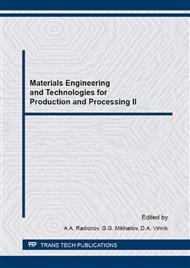[1]
K. Kondo, M. Ueda, K. Ogawa, H. Amaya, H. Hirata, H. Takabe, Y. Miyazaki, Alloy design of Super 13% Cr martensitic stainless steel (development of Super 13% Cr martensitic stainless steel for line pipe-1), In: Supermartensitic Stainless Steels'99, Brussels, 1999, pp.11-18.
DOI: 10.17760/d20002442
Google Scholar
[2]
T. Gooch, Heat treatment of welded 13%Cr–4%Ni martensitic stainless steels for sour service, Welding Journal. 74 (1995) 213-223.
Google Scholar
[3]
P. Bilmesa, M. Solarib, C.L. Llorentea, Characteristics and effects of austenite resulting from tempering of 13Cr–NiMo martensitic steel weld metals, Materials Characterization. 46 (2001) 285-296.
DOI: 10.1016/s1044-5803(00)00099-1
Google Scholar
[4]
P. Bilmes, C. Llorente, Toughness and microstructure of 13Cr4NiMo high-strength steel welds, Journal of Materials Engineering and Performance. 9 (2000) 609-615.
DOI: 10.1361/105994900770345458
Google Scholar
[5]
X.P. Ma, L.J. Wang, C.M. Liu, S.V. Subramanian, Role of Nb in low interstitial 13Cr super martensitic stainless steel, Materials Science and Engineering: A. 528 (2011) 6812-6818.
DOI: 10.1016/j.msea.2011.05.065
Google Scholar
[6]
X.P. Ma, L.J. Wang, C.M. Liu, S.V. Subramanian, Microstructure and properties of 13Cr5Ni1Mo0. 025Nb0. 09V0. 06N super martensitic stainless steel, Materials Science and Engineering: A. 539 (2012) 271-279.
DOI: 10.1016/j.msea.2012.01.093
Google Scholar
[7]
Y.Y. Song, D.H. Ping, F.X. Yin, X.Y. Li, Y.Y. Li, Microstructural evolution and low temperature impact toughness of a Fe–13%Cr–4%Ni–Mo martensitic stainless steel, Materials Science and Engineering A. 527 (2010) 614-618.
DOI: 10.1016/j.msea.2009.08.022
Google Scholar
[8]
M.A. Smirnov, I. Yu. Pyshmintsev, K.A. Laev, E.V. Khramkov, D.M. Alyutin, Properties of high-chromium corrosion-resistant steels exposed to high-temperature thermo-mechanical treatment, Vestnik of Nosov Magnitogorsk State Technical University. 3 (2015).
Google Scholar
[9]
A.M. Akhmedyanov, S.V. Rushchits, M.A. Smirnov, Physical and numerical modeling of hot deformation behavior of 20Cr13 steel, Bull. of the South Ural State Univ. Ser. Metallurgy. 13 (2013) 116-124. (in Russ. ).
Google Scholar
[10]
F. Ren, J. Chen, F. Chen, Constitutive modeling of hot deformation behavior of X20Cr13 martensitic stainless steel with strain effect, Trans. Nonferrous Met. Soc. China. 24 (2014) 1407-1413.
DOI: 10.1016/s1003-6326(14)63206-4
Google Scholar
[11]
Y. Cao, H. Di, R. Misra, X. Yi, J. Zhang, T. Ma, On the hot deformation behavior of AISI 420 stainless steel based on constitutive analysis and CSL model, Materials Science and Engineering A. 593 (2014) 111-119.
DOI: 10.1016/j.msea.2013.11.030
Google Scholar
[12]
Z. Zeng, L. Chen, F. Zhu, X. Liu, Dynamic Recrystallization Behavior of a Heat-resistant Martensitic Stainless Steel 403Nb during Hot Deformation, J. Mater. Sci. Technol. 27 (2011) 913-919.
DOI: 10.1016/s1005-0302(11)60164-3
Google Scholar
[13]
C.M. Sellars, W. McTegart, The relationship between the resistance and the structural deformation in the hot, Memories Scientific Review, Metallurgy. 63 (1966) 731-746.
Google Scholar
[14]
Y. Bergström, B. Aronsson, The application of a dislocation model to the strain and temperature dependence of the strain hardening exponent n in the Ludwik-Hollomon relation between stress and strain in mild steels, Metallurgical Transactions A. 3 (1972).
DOI: 10.1007/bf02642584
Google Scholar
[15]
Y. Estrin, H. Mecking, A unified phenomenological description of work hardening and creep based on one-parameter models, Acta Metallurgica. 32A (1984) 57-70.
DOI: 10.1016/0001-6160(84)90202-5
Google Scholar
[16]
A. Laasraoui, J.J. Jonas, Prediction of steel flow stresses at high temperature and strain rates, Metall. Trans. A. 22 (1991) 1545-1558.
DOI: 10.1007/bf02667368
Google Scholar
[17]
A. Vasilev, S. Sokolov, N. Kolbasnikov, D. Sokolov, Effect alloying on activation energy of self-diffusion in -iron, Physics of status solids. 53 (2011) 2086-2092. (in Russ. ).
DOI: 10.1134/s1063783411110308
Google Scholar
[18]
P.J. Wray, Effect of carbon content on the plastic flow of plain carbon steels at elevated temperatures, Metallurgical Transactions A. 13 (1982) 125-134.
DOI: 10.1007/bf02642423
Google Scholar


